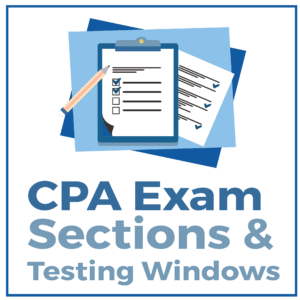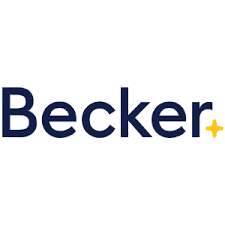Passing the Uniform CPA Exam is an essential step towards getting the coveted CPA license. But before studying, it’s a good idea for all candidates to familiarize themselves with what they are up against.

Anyone interested in becoming a CPA knows that the most important step is passing the Uniform CPE Exam. Once you’ve passed this notoriously difficult test, you’ve officially earned a CPA certification.
If you want to pass the CPA exam on your first try, keep this tip in mind:
One of the biggest mistakes you can make is walking in unprepared. You may have studied hard, but if you don’t know the specifics of each section of the CPA exam, you’re in for a bad time. That’s why it’s important to stay informed throughout your entire study process.
I’ve gone ahead and created a resource you can use when preparing for the CPA exam. It has the specifics of each of the 4 exams, including their test content, time limit, and pass rates. That way you can make informed decisions when planning out your study schedule.
See the Top CPA Review Courses
- Becker CPA Review Course ◄◄ #1 Rated CPA Prep Course of 2025
- Surgent CPA Prep Course ◄◄ Best Adaptive Technology
- Gleim CPA Review Course ◄◄ Most Practice Questions
Universal CPA Exam Format
As I stated above, the CPA exam is split up into 4 different tests. Each of these focuses on a major aspect of work as a CPA. Because of that, the content of each test ends up being highly specialized, but the format of each exam is similar.
Each part of the exam includes multiple-choice questions and task-based simulations. Typically, each of the 4 parts has between 60-70 multiple choice questions and 8 task based simulations. But there’s one notable exception to this rule; the BEC exam only has 4 task based simulations since it also includes an additional 3 written communication problems.
Task-based simulations are examples designed to mimic problems that a CPA will run into during their work. You’re expected to come up with a reasonable solution within the time limit given. Since these are more free form, they’re graded differently from multiple choice problems.
Written communication problems give you an overview of a situation that professional CPAs will have to deal with. You’re then asked to write a formal response that addresses and solves the problem. The format of your response can vary: it can be an email, letter, or company memo. It’s a test on business communication, after all!
The AICPA provides a CPA exam blueprint that gives a detailed breakdown of each CPA exam section. You can find more specific information there, or you can see our quick summaries of all four CPA exam sections below!

Auditing and Attestation (AUD)
According to the CPA exam blueprint, the AUD exam asks you to demonstrate competency in 4 key content areas. Each area covers a specific portion of the exam, which are:
| Content Area | Concepts | Allocation |
| Area I | Ethics, Professional Responsibilities and General Principles | 15-25% |
| Area II | Assessing Risk and Developing a Planned Response | 25-35% |
| Area III | Performing Further Procedures and Obtaining Evidence | 30-40% |
| Area IV | Forming Conclusions and Reporting | 10-20% |
Pass rates for this section of the exam are 2nd lowest at 52.84%. Knowing that, you’ll want to dedicate extra time to this section so you can pass AUD on your first attempt. I’d recommend taking this one early in your schedule so you can get it out of the way first.

Business Environments and Concepts (BEC)
Much like with the AUD exam, the BEC exam asks you to display competency in a few key areas, However, this test consists of 5 content areas. You’ll specifically be asked to prove your understanding of the following concepts:
| Content Area | Concepts | Allocation |
| Area I | Enterprise Risk Management, Internal Controls and Business Processes | 20-30% |
| Area II | Economics | 15-25% |
| Area III | Financial Management | 10-20% |
| Area IV | Information Technology | 15-25% |
| Area V | Operations Management | 15-25% |
It may look tough, but this section actually has the highest pass rate in 2020 at 65.56%. Thanks to that, this one might be worth taking later than the others, so you can end on a high note. On the other hand, taking this section first can help you build the momentum needed to crush the other exam sections, so it’s up to you!
Bear in mind that this is the only part of the test to include written communication questions. Those will require additional studying to get right on your first attempt.
Check out our article on the Top 11 Tips to pass the BEC CPA exam.
Learn More About The CPA Exam
- The Ultimate Guide To The Audit Exam
- CPA Salary Guide: How Much Can You Make?
- CPA Exam Sections & Testing Windows
- 43 FAQ's for CPA's
- Top International Destinations to Take the CPA Exam

Financial Accounting and Reporting (FAR)
As with the other sections, the FAR exam wants you to prove your competency in 4 content areas; these are related to specific aspects of financial accounting. Here’s what subjects you need to know and how much of the exam they make up:
| Content Area | Concepts | Allocation |
| Area I | Conceptual Framework, Standard-Setting and Financial Reporting | 25-35% |
| Area II | Select Financial Statement Accounts | 30-40% |
| Area III | Select Transactions | 20-30% |
| Area IV | State and Local Governments | 5-15% |
According to the AICPA, the FAR exam has the lowest pass rate. Only 49.98% of people passed this test in 2020. In light of that, I’d recommend taking this test first or second so you don’t have to worry about other scores expiring if you fail.
Get The Best Discounts On Your CPA Review Course!

Cyber Week Sale – $1,521 Off Becker CPA Pro+

Cyber Week Sale – $1,520 Off Becker CPA Pro

Cyber Week Sale – $1,050 Off Gleim CPA Premium Pro Course

Regulation (REG)
Last but not least is the REG exam. Like the BEC, you’ll be asked to display competency in 5 content areas. Each of these relates to regulations for CPAs in key ways, which you can see in the table below:
| Content Area | Concepts | Allocation |
| Area I | Ethics, Professional Responsibilities and Federal Tax Procedure | 10-20% |
| Area II | Business Law | 10-20% |
| Area III | Federal Taxation of Property Transactions | 12-22% |
| Area IV | Federal Taxation of Individuals | 15-25% |
| Area V | Federal Taxation of Entities | 28-38% |
Once again like the BEC, this looks a lot tougher than it really is. In 2020, this test had the second highest pass rate of 62.29%. It may be worth saving this exam for last so you can focus on the most difficult exams first.
Check our our article on the Top 11 Tips to pass the REG CPA exam.

CPA Testing Windows and Score Release
There are currently 4 major testing windows for the CPA exam. According to NASBA, they are:
- January 1 – March 10
- April 1 – June 10
- July 1 – September 10
- October 1 – December 10
Typically, you will have 18 months to pass all 4 parts of the exam, though that may vary based on the state you live in. Try and shoot for completing it within one year so you have time for retakes if something goes wrong.
Scores for the 2025 CPA exams are released on a rolling basis. This means you’ll usually receive it within a month of completion, but there are exceptions to that rule. Make sure to check out the AICPA’s page on score releases for the exact date you’ll receive your exam score.



